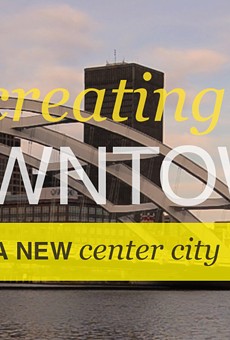When we moved our young family here, Rochester was a very different place than it is now - downtown, perhaps, the most different of all. Downtown, its bustle, the Eastman School, helped convince Bill that Rochester was where we should live - "You won't believe this place," he had said, calling me in Florida from a payphone in the Sibley's grocery store - and once we arrived, he couldn't wait to show me what downtown was like.
So on our first night here, we drove downtown, parked in the Midtown Plaza garage, rode up the escalator, and walked into Midtown's magic, lights blazing on a huge Christmas tree, crowds packing the stores.
That was then. Today, the crowds are gone. Midtown is gone. Sibley's, the National, Edward's, Whillock Bros.: all gone.
Rochester tried everything to stanch the bleeding. We built enclosed overhead walkways that were supposed to help downtown businesses by keeping people warm in the winter and instead simply finished killing off the street life. We tried converting the Edwards Building into an indoor shopping complex called The Mill (an initiative that opened more than a year late, brought in principally small food operations rather than the hoped-for retail shops, and closed less than two years later.)
And for good or for ill, we failed to get Renaissance Square off the ground. But we're still getting a new downtown campus for MCC. We have a transit center. And we should consider ourselves lucky that we've managed to save as many of downtown's significant old buildings as we have, to serve the new purposes they're being converted to now. Their age is an attribute.
Those are not the only bright spots from downtown's decades of decline. We tend to think that Ren Square and The Mill typify the way Rochester operates. But when I look back, those two failures seem more like large, painful blips in a story that contains an amazing amount of knowledge and solid urban planning, bolstered by determination and faith in the city.
What happened to Rochester's downtown wasn't unique: suburban sprawl was killing center cities everywhere. But Rochester's situation was particularly tough, because cities in New York State can't annex suburbs as the population spreads out.
In spite of that, and in spite of the decline of major industry, downtown Rochester seems to have turned the corner and started a slow but measurable climb back up. Over the next few months, our writers will be looking at the progress, in housing, business, and arts and entertainment.
As we start, it's worth paying tribute to a few of the people, no longer living, who built the foundation for what we're seeing now. To Mayor Tom Ryan, who hired a professional staff and consultants whose understanding of urban planning saved us from suburbanizing downtown. To Gil McCurdy and Angelo Chiarella, whose personal commitment to downtown kept Midtown Plaza alive and contributing to the city longer than seems humanly possible. To early downtown housing promoters Mac and Anne McQuay, who preserved the Gibbs Street Townhouses and tirelessly preached downtown's attributes. And to architect and Grove Place leader Bob Macon, whose vision of robust downtown housing development we're beginning to see come to life, and whose architecture helps the Eastman Theatre anchor and enliven a crucial section of Main Street.
It's a solid foundation, but no one can predict the future. Is this growth sustainable in a region where the population is relatively flat?
Equally important: if the growth continues, will Rochester's future downtown serve all people in this diverse community? I can't imagine that we'll experience the stratospheric real estate prices that the tech boom has caused in San Francisco, but even moderate growth can put property out of reach for low- and middle-income residents and small retailers.
Careful planning and development incentives can guarantee that downtown will serve and benefit all of us. And the time to think about those is now, before development pressure heats up.
We encourage your comments as we continue this series this winter.
